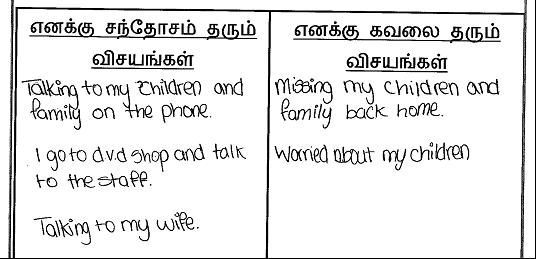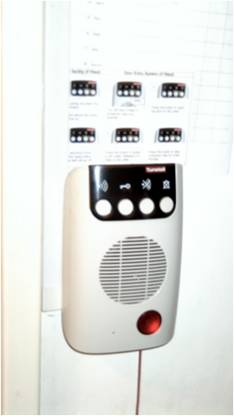Case 12: Kannan
Social, cultural and historical context
Kannan is a 76-year-old man, originally of Indian (Tamil) origin, though he was born in Malaysia and spent the war years in Singapore. He moved to the UK 38 years ago. He worked for the British Navy abroad; when he moved to the UK he did various manual jobs in the steel and automobile industry. He now lives with his wife in a one-bedroom first floor sheltered flat with a warden; they have lived there for 13 years. His two children and two grandchildren all live in India. He and his wife are Hindu.
Participant's experience of ageing and ill health
Kannan’s main medical problem is type 2 diabetes (on insulin) for about 10 years. He also has high blood pressure, arthritis and a “hormone deficiency”. His diabetes is mostly very well controlled, but on one occasion his blood sugar level dropped after he missed a meal, and he woke in the night sweating and confused; his wife called an ambulance and he was given an injection.
Kannan has troublesome pains in his shoulder, neck and back. These are present every day. He attributes the chronic pain to working at the steel plant and doing hard manual work for many years. Going shopping, carrying bags and housework (e.g. vacuuming) make the pain worse, but he carries on doing these activities anyway. He takes painkillers prescribed by the GP, and uses tiger balm to massage his shoulder.
People in the participants' lives
The most important person in Kannan’s life is his wife. She is very supportive, but tends to go out or stay in the kitchen when the (male) researcher is present. He has telephone contact with his son and daughter (and two young adult grandchildren), sometimes three or four times per day. He uses a landline with speaker. His wife takes the lead role in initiating calls and speaking. The home is full of family photographs and art work by his daughter. Kannan uses the research camera to document these pictures.

Daughter’s artwork hanging in the home, and the kitchen (photos taken by Kannan)
Kannan’s nephew (brother’s son) lives locally. He is very busy with his work but they speak frequently on the telephone and see him about once a fortnight. One Tamil lady lives in the same building and visits their flat; Kannan and his wife also visit her (he says this is partly because her family live far away and she needs the company). They have many other relatives in India with whom they keep in contact by phone.
Kannan visits an old friend (originally from Sri Lanka) several times a week. Kannan and his wife take turns to walk the friend’s teenage daughter to and from school daily. When completing the research scrapbook (which had been translated into Tamil), Kannan dictated what he wanted to say in Tamil and the girl wrote this down in English.
What matters to this participant?
Health matters to Kannan. He says he worries about his diabetes. Kannan’s brother also had diabetes; he did not take care of himself, ended up having both feet amputated and died last year from complications. Kannan manages his diabetes very strictly. The hospital staff confirm that he is well controlled and 100% reliable with his appointments. He tests his blood sugar and records the results neatly and precisely in a book once a day. His meals are carefully planned and organised around the diabetes, though he does not always do things at set times. He says he also takes care to exercise, eat a healthy diet and take his medications correctly.
Walking is one of Kannan’s main ways to maintain blood sugar control, and he greatly enjoys this activity (“I must go out”). He goes out at least three times daily, and his evening walk typically covers around 5 Km. Sometimes he sits on a bench near the tube station for a long time, to watch the scenery, pigeons and people walking past. He stresses that he does not have a nap in the afternoon like many other people. He uses his Freedom pass on buses.
Family matters to Kannan, though it is difficult being in a different country from his children. He misses them and worries about them. He says that sometimes his blood sugar is affected by family problems coming from India even when he “does everything correctly”. He says there are similar troubles in every family. Kannan would very much like to go to India. His wife went two years ago but he has not been for six years. He cannot go because money is a major worry. Kannan took out a bank loan several years ago, which he has been paying off. He buys four lottery tickets a week.

‘Comfortable with and concerned about’ list from Kannan’s Home and Life Scrapbook
Kannan and his wife are very independent in their activities of daily living; their nephew helps when a car is needed (e.g. for bulk shopping or going to the airport). They like to be well organised. The small flat is extremely clean and tidy, and everything has its proper place. They get up early and most days follow a similar routine, with Kannan taking two or three walks throughout the day, helping his wife in the kitchen (which he enjoys) and spending most of the rest of the time watching TV, listening to music and talking to his relatives on the phone.
Tamil culture is important to Kannan. He talks a lot about films, music and the magazines imported from India. He spends a lot of time in a Tamil CD/DVD shop, and uses the research camera to take pictures of the films and music on show there. Religion is also very important. Kannan and his wife pray at home to the Hindu deity Murugan. They go to the Hindu temple on festival days, sometimes with their Tamil neighbour. They stay for about an hour for prayer.

Pictures of Tamil shop, Hindu temple and deity, taken by Kannan
Kannan and his wife like their own company. Whilst he likes his walks, he does not feel the need to go to organised activities outside the home. He used to go to a Tamil community centre but stopped when they insisted he had to become a member. There is a weekly social gathering in the building but Kannan does not attend this. He attends the monthly residents’ meetings. These are conducted in Hindi and Urdu, with translation into English. The main topic seems to be security. Recently, someone left the front door open and all the furniture from the common area was stolen.
Kannan grew up with pets (dogs and cats) and would like to have cats in his flat, but this is not permitted.
Technologies in the participant's home and life
There are three important forms of technology in Kannan’s life: the television (which he watches for news and films); the CD player and radio (which he uses for Tamil films and pop music); and telephones (landline and mobile).

‘Objects map’, showing television and radio, from Home and Life Scrapbook
The telephone is particularly important, especially for contact with family. The flat has a ‘telecommunications centre’ located in one corner on the top of a low cupboard in the living room. On it are two landline phones (one cordless) and the mobile phone with charger. This is where Kannan and his wife sit when they phone family in India together using the loudspeaker. Kannan also has a ‘Nokia’ mobile phone. He always takes it with him when he goes out. He calls his wife sometimes to check about the shopping.
Kannan has no computer and has never learnt to use one. He says he would be interested in technology like Skype, but how could he afford this?
There is a telecare pull cord in every room, as well as a smoke detector in the hallway. All are linked to a Tunstall control unit located near the front door. This unit is the alarm control and door entry system. They were installed after Kannan moved in as part of a scheme for the whole block; he did not request them. Kannan understands what the alarms are for.

Tunstall control unit in Kannan’s flat
Materiality and capability
Although Kannan has a number of health conditions, these are currently inconveniencing rather than limiting him. The pain from arthritis has not yet stopped him from remaining mobile and independent. He finds his insulin injections painful – the skin on his legs and stomach is hard and the needle does not enter easily – but he is confident and skilled at all the standard self-management tasks.
The purpose-built, modern flat has many material features that help this couple. It is all on one level, easy to maintain and has a very accessible shower room and toilet. All rooms are potentially wheelchair-accessible, so if one of them became more disabled, structural adaptations to the home would not be necessary. However, there is no lift. The presence of an on-site warden is reassuring, though neither Kannan nor his wife are yet at the stage of needing close support.
Kannan’s technical skills are a great asset to him and his wife. He set up the television, freeview box, Sun TV box, DVD and video recorder himself, including purchasing a multiple scart plug from Argos. He is very interested in the digital camera that he is lent as part of the research. He picks up how to use it quickly and tries it out immediately. He asks how much it costs and where we bought it. By the time of the next research visit, he has changed the batteries and taken some video footage as well as numerous photos.
Interestingly, despite Kannan’s ability and keenness to take up new technologies, he does not use text messaging. He says this is because the small buttons and screen on his mobile phone make this physically difficult when out and about.
Real incidents of using (or choosing not to use) an ALT
The telecare pull cords in all the rooms were untidy and getting in the way so Kannan has tied them up. They are now much neater and out of the way. He has never needed to use the alarm, but once pressed it by mistake. Someone called him through the unit – he said he was fine and no further action was taken.
As part of their Hindu religious rituals, Kannan and his wife light a lamp and camphor candle every day. However, if they do this in the living room (which they would like to do), the smoke detector sets the fire alarm off. In the past, the fire engine has turned up since the alarm is connected directly to the fire station. Almost every family in the building has set the alarm off, often while cooking. To avoid such a scenario, Kannan and his wife perform their prayers in the kitchen, which would not be their choice as a place to worship.
Comment
This case illustrates an individual who is currently managing well with chronic progressive illnesses and who currently still contributes significantly to his community (he walks a friend’s child to school and commits to visiting a lonely compatriot regularly). He has a close and supportive marriage and is also living in a purpose-built physical environment that is likely to be able to accommodate his needs into the future.
Kannan is potentially a candidate for proactive input to set him up optimally before he deteriorates physically and/or cognitively. Notably, he is still able and keen to learn how to use new technologies, yet currently he does not even have a computer. Significantly, what limits his ‘digital empowerment’ is not his attitudes or abilities but material poverty. For a man who makes international calls to his family several times a day, the advantages of an Internet link are self-evident. But ‘prophylactic’ installation of the necessary technologies is nobody’s financial responsibility. It is, however, worth noting that Kannan and his wife seem to communicate extensively and to their own satisfaction using plain ordinary telephone lines (presumably via a special ‘friends and family’ deal).
One reason why Kannan is managing well is that he is physically fit and takes scrupulous care of his diabetes (which, if poorly controlled, would probably make him feel very tired). He feels proud that he does not need to take an afternoon nap – unlike many people with chronic health problems whose energy levels are much lower. As other cases in this sample illustrate, it is often non-specific impairments such as tiredness that prove limiting in maintaining independence and using assistive technologies. Kannan’s case suggests the hypothesis that regular physical activity may be one way of minimising these non-specific aspects of functioning.
Kannan does not yet need assistive technologies so he has disabled the ones that got in the way. This may not matter much now, but a learning point is that for a scrupulously tidy individual, assistive technologies may represent mess rather than protection.
Like several other participants in this sample, Kannan’s home is also a place of worship. One particular religious ritual involves an activity (burning incense) that risks triggering one of his assistive devices. There is no easy solution to this problem since the alarm cannot distinguish between ritualistic and accidental burning. Whilst Kannan and his wife have sensibly initiated a workaround (praying in the kitchen), other older people might see the trade-off between religiosity and safety differently and disable the smoke alarm.